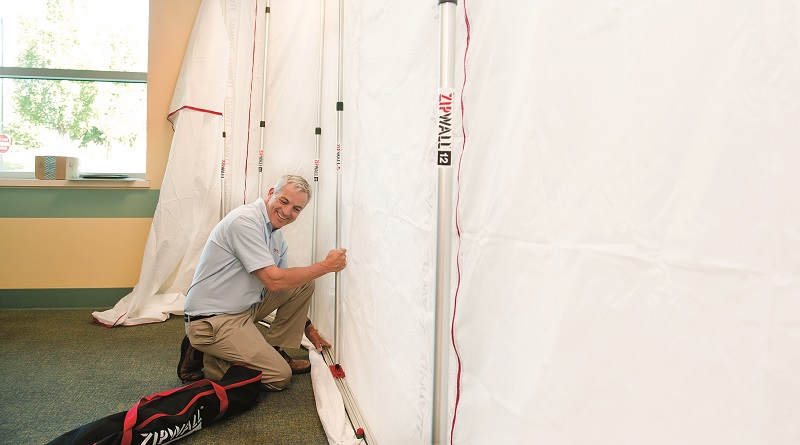Dust & Healthcare Don’t Mix: Providing Construction Contractors with Dust Protection
This expert article was contributed by Tim Allik, a writer and editor living in Greater Boston who covers a variety of subjects, including healthcare.
Contractors who work on renovation and remodeling projects in hospitals and healthcare facilities face special challenges when it comes to dust control, and the stakes are high. It could even be a matter of life or death. This is not something that many people would realise, and issues like this might become more apparent if people read a Contractors Blog for a day in the life of the profession. It is one of the most dangerous jobs in the world.
Invasive aspergillosis (IA) is a fungal infection responsible for severe illness and mortality, particularly in immunocompromised patients. According to a 2009 report published in Medical Mycology, most hospital outbreaks of aspergillosis have been linked to failure to control the spread of contaminated dust or debris on hospital internal construction and renovation projects.
Because of the well-documented risks of dust in healthcare settings, the Centers for Disease Control and Prevention (CDC) requires hospitals to perform an Infection Control Risk Assessment (ICRA) before any construction, renovation or repair project takes place – and to include a dust control plan as a part of this assessment. A growing number of contractors are using the ZipWall Dust Barrier System as a key component of their dust control plan.
An Essential Tool in the Commercial Contractor’s Toolbox
Jacob Bowler, project supervisor for Suffolk Construction, a large commercial construction company that works in the healthcare space in Greater Boston, says ZipWall dust barriers are a go-to solution for dust control. “The ZipWall system is fast and easy to set up and take down. It doesn’t disturb the existing structure and it does a great job of dust containment,” he says. “It’s also easy to set up negative air with a ZipWall barrier.”
The ZipWall Dust Barrier System is a comprehensive dust protection solution for construction, remodeling, and renovation. Contractors use it to isolate the work area and prevent airborne dust from dispersing. The patented ZipWall spring-loaded poles can be set up in just a few minutes without ladders or tape, and without damaging surfaces. Specialized accessories complete the system, adding important features such as tight sealing and entries in the barrier.
Flexible and Adjustable For Many Hospital Dust Control Situations
In hospitals and healthcare facilities, the multiple ways contractors use the ZipWall system depend on the ICRA requirements for the particular project.
“Hospitals have four levels of controls, depending on patient needs,” says Patrick Brower of Wise Construction in Boston, who has worked on many projects in major hospitals in Greater Boston. “These controls dictate what we have to do to protect the area.”
Brower says he appreciates the ZipWall system’s ability to quickly adapt to control dust at any jobsite, from narrow hallways to large spaces with high ceilings.
“We use the ZipWall system because it provides a flexibility that traditional building materials do not,” says Brower. “It’s flexible and the tools are manageable enough that we can quickly create a barrier of any size for any location.”
The ability to set up temporary dust protection walls quickly makes the ZipWall system uniquely suited for emergency projects and those that need to be completed fast, particularly on nights and weekends when time is limited.
Keeping Dust Under Control When Building Semi-Permanent Barriers
For longer-term projects, CDC regulations require the construction of semi-permanent barriers using paneling, bracing, and drywall. Lynchburg drywall contractors can come and build the structures but the process of building these temporary walls creates dust that also must be kept under control.
.
“Whenever we build temporary enclosures out of drywall or other materials, we use ZipWall barriers for dust control to create a vestibule around it,” Brower says. “It’s clean going up, it goes up and comes down fast, and it works.”
Suffolk Construction recently geared up to start a longer term project – a new garage addition and pedestrian walkway at a large hospital in Boston.
The project required construction of a semi-permanent containment wall, but before the wall could be built, a temporary dust protection barrier was needed. Suffolk has been using ZipWall products for this purpose and many others for several years.
Contractors also say they often use ZipWall dust barriers to build temporary vestibules at the entrances to large projects to abide by CDC regulations.
“We create sort of an ante-room to provide construction workers with a place to prepare for entry and exit to and from the jobsite,” says Bowler of Suffolk Construction.
Time Saved, and the Bottom Line
The contractors who use the ZipWall Dust Barrier System say it saves them a significant amount of time and money. On some off-hours hospital and healthcare facility projects, barriers must be put up and taken down frequently, sometimes on a daily basis. The ZipWall system takes minutes, rather than hours, to install and remove, and it only takes one worker to do it, not several. The time saved on these projects can even mean the difference between a profit and a loss on some jobs.
“Cost is definitely a factor,” says Brower of Wise Construction. “The biggest expense in our industry is labor. Anything you can do to save minutes saves dollars.”

